Instantiation Read online
Page 35
“Do you have an image you can mail me?”
“Yes.”
When the file came through, it looked like some kind of collage. In the center of the frame, a circular region contained a modestly dense star field – nothing special in itself, but it seemed to have been cut out of an image taken in the star-rich galactic plane, and then pasted into a different one with a substantially sparser background, as befitted the region’s actual coordinates. A sudden shift in line-of-sight density like this could always arise by pure chance. But unless both Farley and Gabrielle were horribly confused, none of the stars in the center here had been present the last time anyone looked.
“I’m sure I can get you time on the AAT,” she told Gabrielle. “We need to take some spectra, for a start.”
“What do you think this is?”
Fatima stared at the image. “Maybe some kind of lensing event?” That didn’t make much sense, though. A chance alignment between a black hole and a distant cluster of stars might magnify and brighten the cluster’s image, but the scale and the geometry weren’t really compatible with that: with this much brightening, whatever was magnified should also have been warped into a pair of arcs centered on the hole. “Put out a telegram just saying what you see; there’s no need to try to interpret it. I’ll make the booking straight away, and send you the details.”
“Thank you.”
Fatima was able to get an emergency slot starting at two a.m. At least Octans was so close to the pole that it never set over Siding Spring.
She emailed Gabrielle and went back to bed, but then she lay awake pondering the discovery, struggling to piece together some kind of viable hypothesis. What if the gravitational lens responsible was more complex than a single black hole? Maybe two or three foreground galaxies – too dim and distant to show up themselves – were working in concert to produce the image, partly correcting each other’s distortion.
At four o’clock, Fatima got up and checked her emails, but Gabrielle hadn’t sent her anything yet. She walked down to the study and called her.
“I’m still looking at the data,” Gabrielle explained. “I don’t want to make a fool of myself.”
“But what do you have so far?” Fatima pressed her.
“No supernovae. They’re just a whole lot of main sequence stars, with nothing special going on.”
“What about red shift?”
“All less than ten to the minus four.” Gabrielle sounded almost apologetic, as if the phenomenon’s stubbornly inconsistent details were her fault.
“Okay.” So the stars were not in a distant galaxy – and it was unlikely that even a single gravitational lens lay in front of them.
“There’s something else.”
“Go on.”
Gabrielle said, “Between the first exposure I took and the latest, seven new stars appeared.”
Fatima considered that. “Where, exactly?”
“On the edge of the central field.”
If this was a lensing event, and the alignment was delicate enough, maybe the image could change in a matter of hours as the magnified region shifted. “And some stars disappeared on the other edge, right?” Fatima asked.
“No,” Gabrielle replied. “The new stars appeared all around the edge. It’s not shifting, it’s growing larger.”
3
Fatima’s computer chimed, then brought up a plot of the latest data from Chile: a time series giving each new star’s angular distance from the center of the anomaly. “The growth looks close to linear,” she mused. “About two thirds of an arc-minute per hour.” But almost anything looked linear on a short enough time scale.
“So is the wormhole staying still and getting larger?” Gabrielle wondered. “Or is it a fixed size, but moving closer?”
“I’ve never believed in wormholes,” Fatima confessed. “Take two in relative motion and you’ve got a time machine. And I definitely don’t believe in time machines.”
“Maybe you can believe in just one wormhole at a time,” Gabrielle replied, deadpan.
“There are schemes that could supposedly turn just one into a time machine,” Fatima recalled. “But … never mind. Let’s stick to what we can see.”
She glanced out the window of her office; the late-morning sunshine bathing the campus felt jarring, as if she were jet-lagged. Neither she nor Gabrielle had had a chance to sleep before Cerro Tololo took over the observations and fresh data came flooding in, but there’d have to come a point where they worked out a roster that allowed them to take turns resting.
“Suppose this … whatever it is … has a fixed geometry and it’s just moving closer,” Gabrielle proposed tentatively.
Fatima said, “Go ahead and try it out.”
Gabrielle did the calculations. If the changes they’d seen were due entirely to the thing’s motion, it should have been visible telescopically for months before Farley spotted it – but an automated wide-field survey had imaged the area three weeks before and found nothing out of the ordinary. More absurdly, though, pursuing the model into the future implied that whatever it was would arrive at the Earth in about eighteen hours – a prediction that lost its apocalyptic potency when Fatima realized that if the true growth was simply linear, it was now eighteen hours since the zero point … and however long after that moment they’d chosen to try matching Gabrielle’s model to the data, the model would have forecast a collision an equal time later.
“I love it when the mathematics throws your assumptions back in your face,” Gabrielle joked ruefully.
“So what if we assume this thing is growing from a fixed center?” Fatima suggested.
This time the verdict was more elusive. If the anomaly was a sphere expanding at a constant rate, then merely observing how fast its angular size was changing couldn’t pin down both the distance to its center and the rate of growth. They could plug in any speed they liked and get a matching distance, or vice versa. But to make the distance suitably astronomical demanded a relativistic velocity for the sphere’s border: at a mere twenty light-years, it would need to be expanding at 99.9 percent of light-speed.
Fatima’s phone rang. It was Daniel from the press office, nagging her again to draft a statement staking the university’s claim over this epochal discovery.
“We don’t even know what it is!” she insisted. “If we start putting out half-baked theories, we’ll just make fools of ourselves.”
“It’s all over social media,” Daniel warned her. “In an hour or so, when it hits the news outlets, whoever’s on screen explaining exactly where this wormhole is and what it’s doing will own the story.”
“‘Own the story’? What’s that supposed to mean?”
“They’ll be the one that everyone comes to for the definitive answers.”
“You mean the definitive answers that I just told you I don’t have?”
Daniel tried a different tack. “You made the first observations. Who else should do the honors and explain to the public exactly where the current state of knowledge stands?”
“Brian Farley and Gabrielle Chan made the first observations.”
“Is Ms Chan with you?”
Fatima held the phone to her chest and whispered, “Do you want your thirty seconds of fame now?”
Gabrielle shook her head vehemently.
“Sorry,” Fatima replied. “She was up all night, and I think she came down with the flu.”
“Send me something,” Daniel pleaded.
“I will, I will,” Fatima promised him soothingly. She hung up. “As soon as I have the faintest clue what’s going on.”
4
It was dusk when Fatima finally left the campus. As she waited for the bus she looked to the south, but the Pane – as people were now calling it – was still invisible against the pale sky.
She had to accept that there’d probably be no way to determine the Pane’s true distance and motion until more data was in … but every time she tried to set one puzzling aspect of the thing asi
de, a different one resurfaced. She did not believe in wormholes, but if they existed at all she was pretty sure that they ought to bend light. If you arranged for incoming light rays to converge on one mouth of a spherical wormhole, like pins in a pin-cushion, they’d need to emerge from the other mouth in the same configuration, only now they’d be diverging – without having passed through a common central point, or the wormhole would be blocked by an untraversable bottleneck. So the light needed to make a kind of U-turn, even if the two halves of the U lay at different ends of the wormhole.
But the Pane was proving stubbornly un-refractive. Once a new star appeared within the growing circle, its location didn’t shift at all; this window, which should have distorted the view like a thick concave lens, seemed more like an empty frame. There were toy models of cubical wormholes, and other polyhedra, where all the curvature was concentrated along the edges – but even if this wormhole was shaped more like a geodesic dome than a sphere, the images of the stars should have jumped as they crossed behind the dome’s numerous edges.
When Fatima arrived home she could smell dinner cooking. “Now I remember why I married you!” she called out to Salif.
“Don’t tempt fate,” he replied, as she entered the kitchen. “The Minister’s still threatening to relocate his whole department to some benighted country town in his electorate. Who’ll cook for you then?”
“You’ll quit and stay here with me, won’t you?”
“I might check the weather in the new location first. There are only so many winters in Canberra I can take.”
He was smiling, but Fatima recalled the promise she’d made: five years here, then she’d move on. Her position at ANU had always been intended as a step along a path that ultimately took them, if not all the way back to Senegal, at least somewhere closer to home.
They sat down to eat, with the television on. The Pane was unavoidable, but Fatima tried not to wince at all the nonsense it was generating. “We’re almost certainly catching our first glimpse of an alien transport network that criss-crosses the galaxy!” a celebrity string theorist from New York enthused.
“So what we’re seeing is like … a new subway station under construction?” the interviewer asked.
“That’s the perfect analogy! But as well as seeing the entrance to the station, we’re seeing all the way through the tunnel to the destination at the other end! In this subway, every tunnel is much shorter than the distance between the stations it joins!”
Fatima could understand his boyish excitement, his yearning to believe that the universe had been delivered to his doorstep. When she was eight years old, her teacher, Mrs Ndoye, had broken the astonishing news to the class that astronomers had seen a star wobbling from the tug of a planet orbiting around it. Fatima had snuck out of her room that night and looked up into the sky, hoping to witness the stars trembling for herself.
But when she’d told Mrs Ndoye that she planned to visit the new-found planet, her teacher had gently nudged her expectations a little closer to reality. “When you’re older you might study this world, and a thousand others like it. But light itself takes years to cross these distances. How about leaving something for your grandchildren to do?”
Salif caught the look on her face. “So why isn’t it you there, getting the facts right?”
“Because we don’t have the facts.”
“None at all? You’re not sure of even one thing?”
Fatima said, “I know we’re seeing the light from stars that we weren’t seeing a few days ago, and I know that the stars themselves show no signs that they’ve suddenly brightened. But I don’t know where these stars are, or why we’re seeing them now, or what we’ll see tomorrow.”
Salif nodded soberly. “All right, I can be patient. I won’t plan my trip around the galaxy just yet.”
5
“This has to tell us something!” Gabrielle declared. The Chilean team had just observed a blue supergiant – HD 183582, some four thousand light-years away – disappearing behind the Pane.
Fatima was trying to stay circumspect, but she could agree up to a point: having a new constraint like this ought to reinvigorate their analysis. Apart from setting a maximum distance, the event itself had been much like the appearance of a new star within the circle, in reverse. There had been no blurring, no bending of the light; the now hidden star had just winked out, as sharply as if it had gone behind the moon.
“I’ll bet you fifty dollars the next one gets occulted as well,” Gabrielle proposed. HD 184039 was less than nine hundred light-years away, and they’d learn the result by noon the next day.
Fatima smiled. “Why would I take that bet? It’d be too much of a coincidence if the Pane was only just close enough to block the first star we could check.”
Gabrielle seemed to like this answer, but she wanted to push it further. “So let’s assume it could be even closer. Say … less than a light-year.”
Fatima didn’t protest. She’d entertain anything for the sake of the argument.
Gabrielle said, “What’s the natural speed for a change in geometry to propagate through empty space?”
“Light-speed.”
“So what if the Pane is expanding that fast?”
“Ummm … it would have hit us before we saw it coming.” Fatima scrutinized Gabrielle’s face, wondering just how exhausted she was.
Gabrielle shook her head impatiently. “Suppose it’s not spherical, though – suppose it’s circular. If it’s six-tenths of a light-year way, and its radius is growing at the speed of light, that would match the angular growth rate we’re seeing.”
Fatima could see the attraction of the idea. A growing sphere had to grow slower than light or it would have reached the Earth already, but the Pane as they saw it was expanding so rapidly that either the sphere’s border was moving at some arbitrary but still enormous speed, or it would have to be even closer to the Earth than Gabrielle was now proposing.
“Wormhole mouths are spheres, not disks,” she said.
“You don’t believe in wormholes,” Gabrielle retorted.
“I know.” Fatima thought for a moment. “Maybe a disk would make more sense of the optical properties. If you’re just cutting space-time along two flat surfaces and identifying the cuts, you don’t have the same curvature effects … though the rim would still be singular, like a cosmic string under negative tension. It’s hard to see how a structure like that could be expanding at the speed of light.”
“I can’t explain the dynamics,” Gabrielle admitted. “And another catch is that we’re seeing a circle, not an ellipse. What are the odds that a disk would be facing us head-on?”
“Maybe you should sleep on it,” Fatima suggested. “I’ve got a class to teach. We can take this up tomorrow.”
The class was meant to be on methods for observing exoplanets, but Fatima decided to cut her students some slack; even brain surgeons and ambulance drivers were probably debating their own theories of the Pane with their colleagues as they worked, so it would be cruel to expect a roomful of budding astronomers to resist the same urge. She gave them free rein to ask questions or just raise ideas, and did her best to keep anyone, herself included, from shouting down even the craziest suggestions.
“If the Pane actually hit us, would we survive passing through?” Leon asked.
“Do we get to take the sun along, too?” Fatima joked.
“Why not? If the Pane were so tiny it could only fit the Earth, it would have to be so close that someone would have measured its diurnal parallax by now.”
That was a fair point. Fatima said, “Given what we see with the starlight, the curvature doesn’t look extreme – it’s not on the scale of a solar mass black hole, say. But it wouldn’t take that strong a gravitational field to disrupt the Earth’s orbit.”
“So…?”
“We don’t know,” she said. “Maybe we could survive passing through, maybe not. But even if the Pane is big enough to swallow the solar system, we have no
real evidence to show that it’s moving at all, let alone heading straight toward us.”
6
Fatima woke and lay still for a while, turning the problem over in her mind, then she rose and walked in the dark to her study.
She closed the door before switching on the light, then she sat at her desk and picked up a pen.
When Gabrielle had carried out her first calculations – trying to explain the apparent growth of the Pane by treating it as an unchanging object that was simply moving closer – she’d assumed that the size of the thing was negligible compared to its distance. Fatima had never thought to question that; it would have seemed as absurd as disputing the fact that the radius of Mars was much smaller than its distance from the Earth, when you could hide the whole planet behind a match-head held at arm’s length.
But if the Pane was a very large disk, and its center was actually much closer to the Earth than its rim, it could still appear small, covering a tiny circle in the sky, because of the extra time it took for light to travel from the rim. In the original calculations, Gabrielle had used the time lag for the distance from the observer to the center, not the rim, assuming that the two quantities were so close that it made no difference.
Fatima worked out the exact expression, then went back and checked it three times before attempting to connect it to the data.
It was impossible to solve for everything – the size, distance and speed of the Pane – all at once, but the simplest assumption would be that the thing was traveling at exactly the speed of light. If she extrapolated back in time to the moment when its apparent size would have been zero, five hours before Farley’s first sighting, that would be the moment it had reached the Earth. The observed rate of growth then implied a radius of about 450 light-days.
If all of that was true, the Pane was now a couple of light-days away, in the opposite direction to Octans – but the current picture in the sky reflected a time almost 140 years earlier, when the extra distance out to the rim made the hypotenuse of the 140-light-year triangle about two light-days longer than its side – so that starlight on the verge of being blocked by the disk would take two more days to reach Earth than the disk itself.

 Zendegi
Zendegi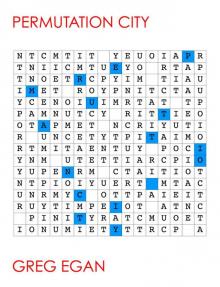 Permutation City
Permutation City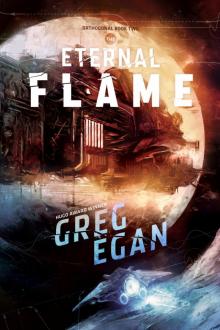 The Eternal Flame
The Eternal Flame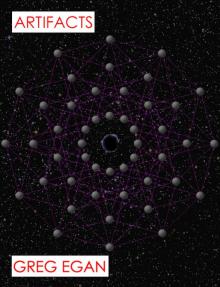 Artifacts
Artifacts Wang's Carpets
Wang's Carpets Dichronauts
Dichronauts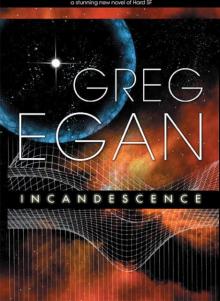 Incandescence
Incandescence Teranesia
Teranesia Schild's Ladder
Schild's Ladder Quarantine
Quarantine The Four Thousand, the Eight Hundred
The Four Thousand, the Eight Hundred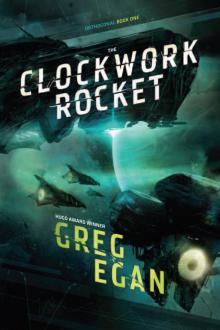 The Clockwork Rocket
The Clockwork Rocket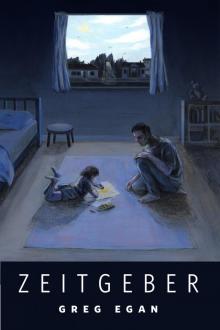 Zeitgeber
Zeitgeber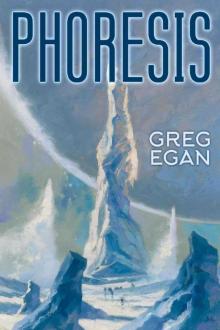 Phoresis
Phoresis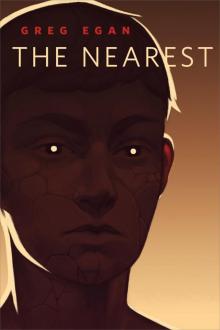 The Nearest
The Nearest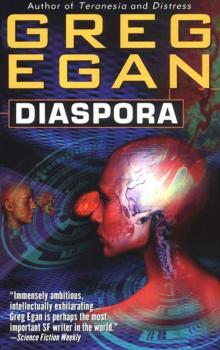 Diaspora
Diaspora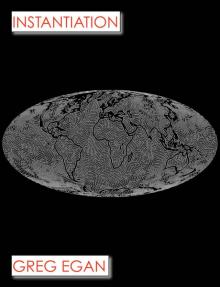 Instantiation
Instantiation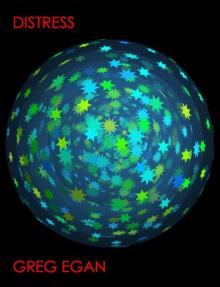 Distress
Distress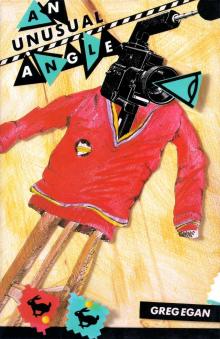 An Unusual Angle
An Unusual Angle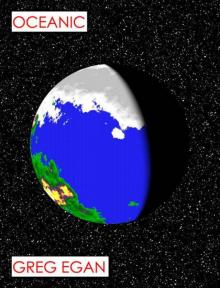 Oceanic
Oceanic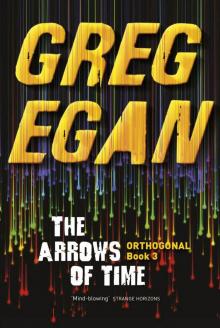 The Arrows of Time
The Arrows of Time Axiomatic
Axiomatic![Anthology 2. Luminous [1998, 2010] Read online](http://i1.bookreadfree.com/i/03/18/anthology_2_luminous_1998_2010_preview.jpg) Anthology 2. Luminous [1998, 2010]
Anthology 2. Luminous [1998, 2010]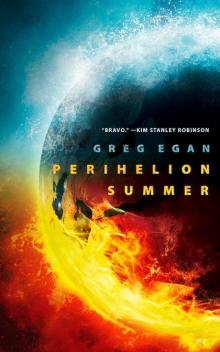 Perihelion Summer
Perihelion Summer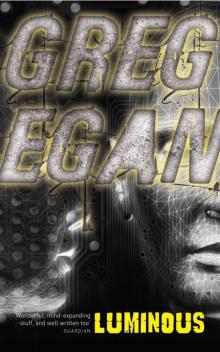 Luminous
Luminous